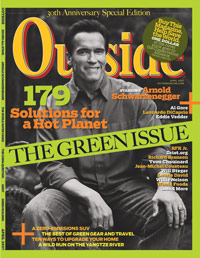The green issue of Outside hits the newsstands today — flip it open, and what to your wondering eyes will appear but some wacko with a chainsaw and a skeptical guy in a newsboy cap. There they are, Grist President Chip Giller and Staff Writer David Roberts, illustrating a feature article about Grist. (Outside likes us, they really like us!) Stop squinting to read the tiny print — check out an excerpt below the fold.
 The following is an excerpt of a feature story in the April issue of Outside magazine, which is now available on newsstands. To subscribe to Outside magazine, click here.
The following is an excerpt of a feature story in the April issue of Outside magazine, which is now available on newsstands. To subscribe to Outside magazine, click here.
[UPDATE: The full text of the article is now up on the Outside website.]
What’s So Funny?
Actually … global warming, solar power, baby seals, carbon dioxide — and that’s just for starters. Thanks to the cheeky enviro-news site Grist.org, greens finally have a funny bone. Now these upstarts want to lead the movement into the mainstream. Seriously.
By Tim Dickinson
IMAGINE THAT WRITERS for The Daily Show staged a hostile takeover of Sierra magazine. Earnest reports on climate change and organic foods would get repackaged with devilish irreverence. There would be jokes about Superfund sites, tree huggers, and the plight of endangered species. Al Gore would be a huge fan-and a favorite whipping boy. People under 40 might actually read it.
Which is to say, you’d probably end up with something a lot like Grist.
An online magazine published out of a 1920s high-rise in downtown Seattle, Grist.org is reshaping green journalism by luring a younger and wider audience with an approach that’s not so much dumbed down as smart-alecked up. The site’s offerings include feature stories, interviews, an advice column, and a blog, though it’s best known for the Daily Grist, which summarizes the top environmental news from the mainstream and alternative press in snackable blurbs.
Each is slugged with a trademark punny headline, which range from goofy (“Hey, Poacher, Leave Those Squids Alone”) to painful (“It Takes a Pillage to Raze the Wild”). When Yao Ming, the seven-foot-six-inch NBA star from China, took a stand against his country’s shark-fin harvesters last August, Grist declared, “No Soup for Yao!” In June, UPS’s announcement that it was testing hybrid delivery trucks inspired “Nice Package.”
The point behind the gags, says Chip Giller, Grist’s tousled 36-year-old founder and president, is to get past the “crust of cynicism” that often surrounds environmental problems. Grist doesn’t aim to make light of the issues — indeed, Giller seems personally weighted by them — but to make their details (and solutions) more palatable. As Giller puts it, “Humor is an effective way to get people to engage.”
Adam Werbach, the former wunderkind president of the Sierra Club who now runs a nonprofit promoting sustainable living, agrees, likening Grist to “a gateway drug.” Readers hooked by the Onion-y headlines find themselves reading serious reports on such unfunny subjects as biofuels and environmental justice-stories that would seem right at home in the pages of The Ecologist or Mother Jones.
In the current frenzied era of Wal-Mart organics, hybrid Chevy roadsters, and a million DVD copies of An Inconvenient Truth, Grist has also embraced green consumerism while renouncing what Giller calls the “historic hippie aspects” of environmentalism.
“We’re trying to focus on the environment as it relates to normal peoples’ lives,” he says. “What they purchase, where they live, what they drive. Not something out there that they go visit occasionally.” Which, Giller says, is why Grist provides “less worshipful language about the caribou in ANWR” and more answers to everyday questions, like the one recently posed to Grist’s lifestyle-advice column, Ask Umbra: “Can I recycle a beer bottle if there’s a lime wedge in it?” (Yep. Just drop it in the bin.)
While the snark attracts a youthful crowd-more than half of Grist’s 750,000 regular readers are in their twenties and thirties-the underlying substance draws praise from veteran reporters and activists.
“As far as I know, every working environmental journalist in the country reads Grist as their tip sheet,” says Bill McKibben, author of The End of Nature and a Grist board member. The Washington Post‘s Juliet Eilperin, who covers Capitol Hill and the environment, credits the Daily Grist with giving her a useful “lay of the land,” while New York Times science writer Andrew Revkin calls Grist’s original stories “serious” and “substantive.” Sierra Club executive director Carl Pope says the site has “raised the bar” for other green publications.
Grist has also become a unique forum for debate, a space where “people talk to each other across the walls of the movement,” says McKibben. In 2005, Grist republished Michael Shellenberger and Ted Nordhaus’s bombshell polemic, “The Death of Environmentalism,” which argued that greens were fading into irrelevance by failing to adequately confront global crises like climate change, then solicited point-by-point rebuttals from the heads of the Sierra Club, the Natural Resources Defense Council, and the National Environmental Trust. More recently, on the Gristmill blog, staff writer David Roberts argued that a Revkin piece in the Times lent credence to industry “shills” who were downplaying the threat of global warming. Revkin fought back in the comments section and even mixed it up with Grist readers.
Revkin and Eilperin both point out that Grist doesn’t often produce groundbreaking news. But the site’s reputation as a comedic lesser light can prove effective at disarming tight-lipped officials. In a January interview with Grist, Representative John Dingell — a powerful, gruff Michigan Democrat and staunch defender of the U.S. auto industry who chairs the House committee in charge of federal fuel-economy standards — flatly admitted that his district’s parochial concerns aren’t trumped by the national interest.
“I’m an American. And I gotta help my country,” he said. “But in a like fashion, I’ve gotta help my own constituents.”
Grist’s strange brew of wonkery and wit can also cause plain old confusion. On April Fools’ Day 2000, USA Today‘s Cesar G. Soriano reported items from Grist’s special lineup of fake news — which included pieces on Pamela Anderson hosting an Earth Day event and Ford’s new “Mastodon” SUV — as if they were fact. Soriano didn’t laugh when he figured it out.
“I don’t care if Jesus Christ himself shows up to clean a river for [Grist],” he later wrote to Giller. “It won’t be published in my column.”
“Sometimes we run into problems with people who are too literal,” Giller grins. “But that’s not our audience.”
IT’S 10 a.m. on a cloudless, frigid October Monday, and sunlight is pouring into Grist’s modern eighth-floor offices, which are a mismatch with the classically ornate Dexter Horton Building. Grist’s staff of 20 moved into the airy, 5,000-square-foot space four months ago, and it still has that barely-lived-in look. The unadorned walls are splashed with shades of mango, cornflower, and cream. The beige carpet is spotless. The furniture is IKEA. Like everything in the nonprofit’s $2.5 million annual budget, it’s paid for by foundation grants, along with a dollop of reader donations and advertising.
Over in the large editorial wing, a windowed space with views of Mount Rainier, Roberts and senior editor Lisa Hymas, both in their early thirties, are supposed to be finalizing headlines for the Daily Grist, which is due to be posted on the home page and sent out in an e-mail newsletter in 15 minutes. Roberts, artistically unkempt, wears a T-shirt emblazoned with a clenched fist and the sunburst slogan SOLAR POWER TO THE PEOPLE! The petite Hymas is braced against the chill in a heavy turtleneck sweater. They procrastinate by giving me a primer on Daily Grist headline history, delivered with the kind of freakish conversational coordination found in seven-year-old twins.
“It was a spur-of-the-moment idea,” Roberts says, “but it’s since become the calling card of the entire Grist operation.”
“It was kind of a fluke,” says Hymas.
“A fateful decision-“
“Which haunts us to this day.”
“It seemed like a good idea five years ago,” sighs Roberts. “But 5,000 e-mails later …”
“There are only so many whale puns-” says Hymas.
“Or Canada puns-“
“Or forest puns. We just keep hoping for a new global calamity that we haven’t punned out. Climate change is getting a little tough.”
“Somebody needs to screw up something else.”
Roberts and Hymas, one-fourth of Grist’s eight-person in-house editorial team, typify the talent Giller has cultivated since founding the site in 1999. Roberts was hired as an assistant editor in 2003, his salary provided in part by $35,000 in reader donations from the Grist Grapefruit Challenge, a pledge drive during which staffers ate nothing but grapefruit for two weeks. He quickly became a force behind the Gristmill blog and is now one of the site’s big guns: In 2006, he interviewed both Al Gore, who talked about An Inconvenient Truth, and Barack Obama, who discussed fuel-economy standards.
Hymas, who’s been with Grist off and on since the beginning, focuses on the site’s original content, which includes Muckraker, a political dispatch by Nashville-based Amanda Griscom Little (who also pens Outside’s Code Green column); Victual Reality, a weekly column about organic edibles; the Grist List, which celebrates green celebrities; and Ask Umbra.
Giller, meanwhile, spends much of his time selling donors on his ambitious expansion plans, which he refers to as Grist 2.0. His goal is to triple the site’s current readership by ramping up its lifestyle offerings — adding a broad range of product reviews, along with personal ads and classifieds — in a bid to appeal to the growing legion of sustainability-minded shoppers who support America’s $30 billion green market.
The buildup, which Giller says will require $10 million in new funding, will put Grist in competition for readers and ad dollars with for-profit sites like TreeHugger and Ideal Bite, which have developed robust followings by blogging about eco-friendly products. (Grist has collaborated with both sites on cross-promotions and content development.) Giller also wants to pump up Grist’s news resources. He envisions Grist as a one-stop portal that attracts and serves consumers, then uses serious journalism to convert them into activists.
At the moment, though, Roberts and Hymas still have to finish their headlines …




